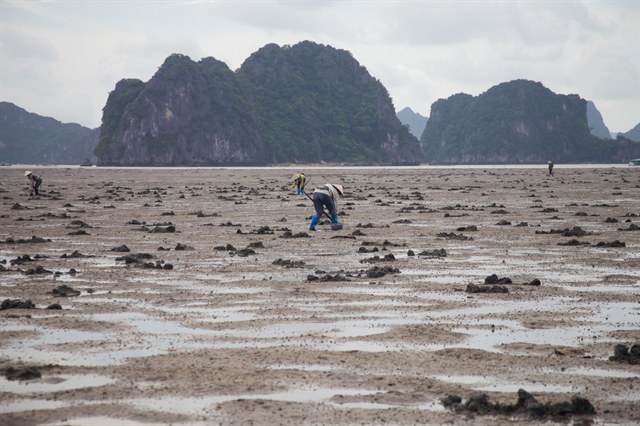 Features
Features

Sá sùng, or sea worms (Sipuncula), might have a less-than-appetizing look, but they are Quảng Ninh Province’s most luxurious seafood and could even be the highlight of your trip

|
| FINGER FOOD: Despite the less-than-appetising look, sand worms can be the highlight of your trip.Photo discover-halong.com.vn |
You might need a little grit to overcome the feelings you have when looking at the slithery appearance of this unusual food.
Sá sùng, or sand worms (Sipuncula nudus), might have a less-than-appetizing appearance, but they are Quảng Ninh Province’s most luxurious seafood and could even be the highlight of your trip.
The sand worms live deep in the sand around coastal dunes. They hide in gaps in the sand at depths between 10 and 30 metres. It is a mollusk, boneless, earthworm-like creature, reddish-brown in colour. They usually have an average length of 5cm to 10cm, but can grow up to 40cm when mature.
They can be found on the coast of Quảng Ninh such as at Vân Đồn and Quan Lạn communes, and are considered a specialty dish that is as expensive as gold: the price of fresh sá sùng is VNĐ500,000-600,000 per kilo and dried sá sùng is up to VNĐ4 million (US$170) per kilo.

|
| SLIPPERY SNACK: Fresh sand worms can be used to make soups. Photo vifoodshop.com.vn |
Why so expensive?
In order to get one kilo of sand worms, catchers have to work really hard. The worms can only be found in coastal sandy areas where the sea water rises and dries up during the day.
When feeding at night, the worms leave holes in the sand, resembling the shape of a star, allowing local fishermen to locate their burrows. When captured, they wrap themselves in a ball and their skin changes colour once they leave the ocean environment.
The hunting process, which includes pinpointing the location of the worms before digging them up under the scorching heat, is tough.
Nguyễn Thị Năm, a resident of Quan Lạn Commune who has been digging sand worms for many years, said having experience was the most important thing to successfully catch the worms.
“You have to be very quick in acting, as the sand worms can move really quick. It is crucial to combine the movement of feet and hands to shovel the sand off,” she said.
She said detecting where the worms were hidden under the sand was difficult, but catching them without killing them was even more difficult.
The inexperienced could easily cut off sand worms’ body, making them hard to sell because cutting them makes them lose their original savoury taste and freshness.
The sand worms are then washed carefully, ensuring that all the sand is removed from their insides. They are washed until turning an ivory-white colour. They can be cooked fresh with boiled water, or dried. The drying process takes about two hours.

|
| DIGGING FOR WORMS: Women of Đông Xá Village in Vân Đồn District of Quảng Ninh Province work hard to find the sand treasure.Photo phunuvietnam.vn |
How are they cooked?
If you’ve had a bowl of phở, chances are that you’ve had a hint of sá sùng’s taste. In the traditional noodle dishes of Hà Nội, sand worms is added to the stock to increase the savoury smell of the broth.
Despite their unpleasant look of wrinkled fingers, dried sand worms are full of umami, with a deep savoury taste. A small amount of roasted dried worms put in a filter bag and added to a broth will make it rich in flavour.
Nguyệt Minh, a resident of Hà Nội, has been cooking phở for her family for many years. She said that since sand worms was incredibly expensive, phở restaurants would only dare use very small amounts, if any.
“If you add sá sùng to the broth pot, the broth becomes remarkably fragrant. Not that all who cook phở will add the worms, but sá sùng takes the broth to another level. The worms are often sandy and you need to roast them in a dry pan before using them,” Minh said.
“Turn and shake the pan until you can smell the worms’ fragrance, they puff up a bit, and darken. Then break them into pieces and shake out the sand. Finally, add them to your pot of phở broth.”
The sand worms were once offered as tributes to kings and mandarins and have long been considered a food of royalty and people of means. Aside from being used in phở, they can also be made into a variety of other dishes, from stir-fries to stews.
Fresh sand worms can be simmered in a pot of porridge, used to make soups, stir-fried, deep-fried, eaten whole in a pot of spicy hot pot, or added to stir-fried dishes along with vegetables and meats, intensifying the flavour of all the other ingredients.
They can be baked, served with salt, chili and lime, and also be mixed with pepper and grilled. Beer lovers tend to have roasted sand worms with their drinks, as like shredded dried squid, it is crunchy and tastes sweet. Anyone who has had sá sùng like this will agree that it is beyond delicious when combined with fresh lettuce and beer.
In order to ensure the sustainable development of sand worms in the face of the dangers of depletion and marine pollution, the People's Committee of Quảng Ninh Province in 2016 issued a decision on conserving the genes of Sipunculus Nudus Linnaeus in the province.
The provincial centre for Science, Technology and Aquatic Seed Production has currently conserved and operated 10 hectares of sand worms in the localities of Vân Đồn, Đầm Hà, Hải Hà and Móng Cái. VNS




